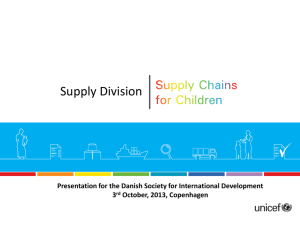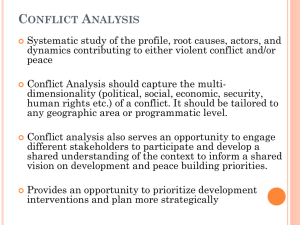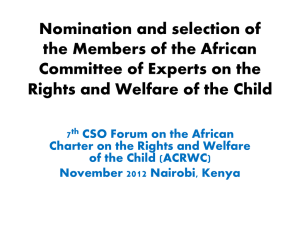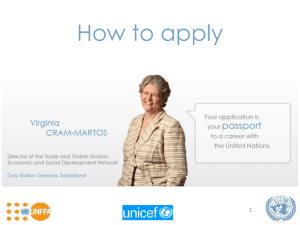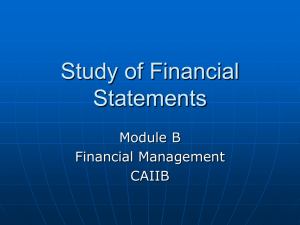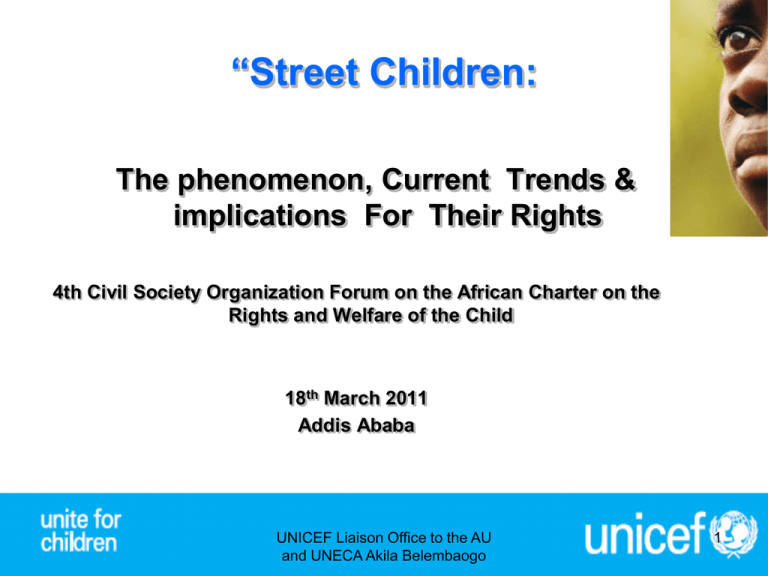
“Street Children:
The phenomenon, Current Trends &
implications For Their Rights
4th Civil Society Organization Forum on the African Charter on the
Rights and Welfare of the Child
18th March 2011
Addis Ababa
UNICEF Liaison Office to the AU
and UNECA Akila Belembaogo
1
“Street Children”
Definition:
“A street child means a child who (a) because of abuse, neglect,
poverty, community upheaval or any other reason, has left his
or her home family or community and lives, begs or works on
the streets; or (b) because of inadequate care, begs or works
on the streets but returns home after night” (The Children’s
Act of 2005, Number 38 of South Africa )
No Child belongs to a street but to a family
UNICEF Liaison Office to the AU
and UNECA Akila Belembaogo
2
Categories of “Street Children”
• Children at risk – children of the urban poor
• Children living on the streets – children for
whom the street is the main living place
• Children working on the streets – children who
come to the streets to work in order to
supplement family income
UNICEF Liaison Office to the AU
and UNECA Akila Belembaogo
3
Reason for Coming to the Streets
• Poverty
• Rapid urbanization and industrialization associated
with the collapse of rural economy
• Structures that leave children unprotected
• Wrong perception that life in a big city would be easy
and fun
• Other social, economic and political crisis such as
epidemics, military and ethnic conflicts, refugee
movements and etc.
UNICEF Liaison Office to the AU
and UNECA Akila Belembaogo
4
Trends
• The phenomenon of children living and working
on the streets is a worldwide problem
• Getting accurate statistical data for “street children” is
difficult given the hidden and isolated nature of life they
lead
• It is estimated that there are about 100 million “street
children” around the world. The figure reaches 150
million in some studies
• UNICEF estimated the figure to be around tens of millions
in 2005
UNICEF Liaison Office to the AU
and UNECA Akila Belembaogo
5
Trends
• There are studies that estimated about 32 million
children live on the streets in Africa
Statistic in some selected cities in Africa:
• Government estimates 150,000 children live on the streets
in Ethiopia and around 60,000 in Addis Ababa
– NGOs estimate that the problem is far worse as nearly
600,000 street children in Ethiopia and 100,000 of these in Addis
– Around 1 million children are believed to be on the streets
of Egypt, most in Cairo and Alexandria
UNICEF Liaison Office to the AU
and UNECA Akila Belembaogo
6
Trends…ctd.
Statistics in Africa…ctd.
• Around In 250,000-300,000 children live and work on the streets
across Kenya with more than 60,000 of them in Nairobi
• In Ghana, around 21,140 street children, 6,000 street babies, 7,170
street mothers under the age of 20 are estimated to live on the
streets of Accra
• There are an estimated 10– 12,000 homeless children in South Africa
• Approximately 110 infants were abandoned on the streets of
Khartoum, Sudan, in 2003, every month, with 50% dying within hours
UNICEF Liaison Office to the AU
and UNECA Akila Belembaogo
7
Trends…ctd.
• The number of “street children” is increasing over
the years.
Between 1991 and 1994
– In Zambia doubled from 35,000 to 70,000
– In Nairobi increased from 4,500 to 30,000
• “Street children” are increasing in Sub-Saharan cities, mostly
because of HIV/AIDS. For example:
– In Brazzaville, Congo, almost half of the street children are
orphans
– In Lusaka, Zambia, the majority of children living on the street
are orphans
• The majority of “street children” belong to the age category of 10
to14 but there are studies that show the age ranges from a low of
6 years to a high of17 years
UNICEF Liaison Office to the AU
and UNECA Akila Belembaogo
8
Trends…ctd.
• The age at which children start living & working
on the streets is decreasing because of the
increasing number of OVCs
• Higher incidence of “street boys” than girls. Major reasons:
– parental fears regarding the dangers of street life for females
– girls are perceived to be more fitting for indoor activities such as
household chores, child minding and working as maids in bars
and back street hotels
– girls are more likely to get involved in commercial sex work
• A study conducted in Eastern and Southern Africa in 1999 in 65
towns and cities found that 74% were boys and 26% were girls
UNICEF Liaison Office to the AU
and UNECA Akila Belembaogo
9
Effects & Implications on Rights
• Often viewed as a threat to the society
– Right to non-discrimination. (Article 3 in the ACRWC)
– Right to protection against harmful social and cultural practices
(Article 21 in the ACRWC)
– Right to protection from sale, trafficking and abduction.
• Suffer from violence and abuse
– Right to protection against child abuse and torture (Article 16 of
the ACRWC)
– Right to protection and privacy (Article 10 of the ACRWC)
– Right to protection from involvement in armed conflicts (Article
22 of the ACRWC)
UNICEF Liaison Office to the AU
and UNECA Akila Belembaogo
10
Effects & Implications…ctd.
• Face health problems, are malnourished, vulnerable to traffic
accidents and have difficulties of accessing medical services
– Right to health and health services (Article 14 of the ACRWC)
– Right to survival and development (Article 5 of the ACRWC)
– Right to parental care and protection (Article 18 of the ACRWC)
• Vulnerable to substance use
– Right to protection from drug abuse (Article 28 of the ACRWC)
– Right to parental care and protection (Article 18 of the ACRWC
UNICEF Liaison Office to the AU
and UNECA Akila Belembaogo
11
Effects & Implications…ctd.
• At a higher risk of contracting sexually transmitted infections
including HIV
– Right to protection from all forms of sexual exploitation (Article
27 of the ACRWC)
– Right to health and health services (Article 14 of the ACRWC),
– Right to survival and development (Article 5 of the ACRWC)
• Loss of an adult care giver relationship,
parental affection and opportunities for growth
– Right to survival and development (Article 5 of the ACRWC)
– Rights to protection from separation from parents (Article 25 of
the ACRWC)
UNICEF Liaison Office to the AU
and UNECA Akila Belembaogo
12
Effects & Implications…ctd.
• Find it difficult to go to school
– Right to education (Article 11 of the ACRWC) and
– Right protection from child labour (Article 15 of the ACRWC)
• Mistreated by the law enforcing bodies
– Rights to administration of juvenile justice (Article 17 of the
ACRWC)
– Right to protection against child abuse and torture (Article 16 of
the ACRWC)
UNICEF Liaison Office to the AU
and UNECA Akila Belembaogo
13
What needs to be done?
• Advocate for the ratification, popularization, implementation of
and reporting on the African Charter on the Rights and Welfare of
the Child
• Use all opportunities to advocate and lobby for the children and
make their voices heard. Day of the African Child – this year, the
main theme is “All Together for Urgent Action in Favor of Street
Children”
• Intentionally target children living and working on the street as
participants, beneficiaries and owners of programmes
. Promote cross-sector programmes to address the
underlying causes (child friendly schools, non formal
Education, vocational training, access to employment
market with protective measures (ILO Conventions)
. Promote national social protection policy (AU social protection
framework).
UNICEF Liaison Office to the AU
and UNECA Akila Belembaogo
14
Thank You!
UNICEF Liaison Office to the AU
and UNECA Akila Belembaogo
15

